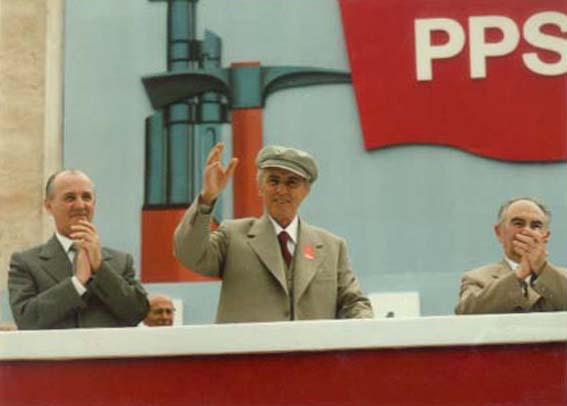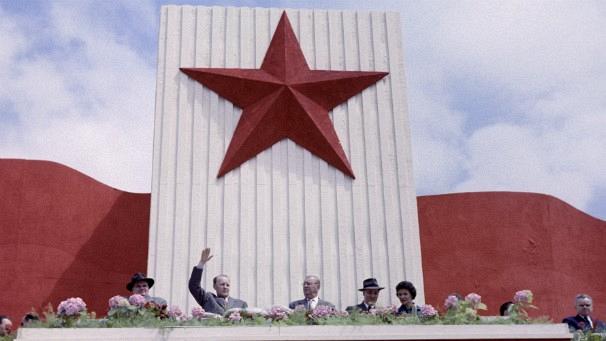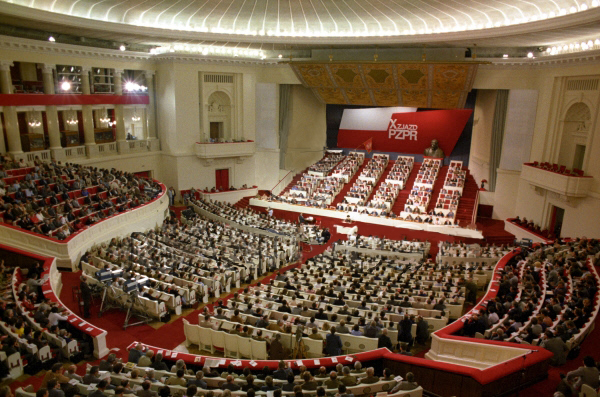From tyrants to social democrats: costumes of the communism in the old Marxist Europe
The European left continually accuses of "fascist" and "extreme right" every conservative party that discusses the progressive dogmas. But almost nobody calls "communist" to that left.
However, in Central and Eastern Europe that was subjected to the Soviet yoke for decades there are many reasons to call "communists" to those who today call themselves Social Democrats. There many political formations that today are presented as social democrats are heirs of parties that exercised power in the communist dictatorships, with exceptions such as Communist parties of the Czech Republic, Georgia, Moldova, Belarus and Russia, which are direct heirs of their predecessors, in addition to the Socialist Party of Romania, today named because they forbade him to use the term "communist". We will see next what disguises chose other unique parties of the European communist dictatorships, among them ten members of the Party of the European Socialists.

Albania: the single party became in Social Democrat in 24 hours
The small republic bathed by the waters of the Adriatic Sea was one of the most hermetic states in the world during the communist dictatorship of Enver Hoxha, which remained faithful to Stalinism. At that time the Albanian Labor Party (PPSH) exercised absolute power in the country. After the fall of communism, the PPSH was dissolved on June 12, 1991, and the following day the Socialist Party of Albania (PPSh) was formed, currently associated with the Party of European Socialists. After a great loss of support in the first half of the 1990s, the new party won the parliamentary elections of 1997, 2001, 2013 and 2017. A curiosity: the Socialist Party of Albania copied the logo of the Spanish Socialist Workers Party (PSOE), also a member of the Party of European Socialists.
Bulgaria: the Communist Party became a Social Democrat ... and allied with the new Communists
During the communist dictatorship, the only party in this country was the Communist Party of Bulgaria (BCP). The same day of its dissolution, on April 3, 1990, it became the Socialist Party of Bulgaria (BSP). Its first president was Aleksandar Lilov, the last president of the BCP and one of the top leaders of the communist dictatorship. The party achieved an absolute majority in the constituent elections convened in 1990 after the fall of communism, winning 211 of the 400 seats in the National Assembly, but passed to the opposition a year later after the first legislative elections. The BSP, which is part of the Party of European Socialists, returned to govern in 1994, 2005 and 2013 forming leftist coalitions. The name of the Communist Party of Bulgaria was adopted by a new formation of Marxist-Leninist character in 1996, which has been aligned with the BSP in all the parliamentary elections since 2001, in coalitions that have also been joined by parties such as the Union of Communists of Bulgaria and the Party of the Bulgarian Communists.
Croatia: the single party disguised itself as a social democrat
Although it remained independent of the USSR, in Yugoslavia there was also a communist dictatorship, whose only party was the League of Communists of Yugoslavia. Its Croatian branch was the League of Communists of Croatia (SKH), which disbanded on November 3, 1990, becoming the Social Democratic Party of Croatia. The new party won the elections in 2000 and in 2011. It is associated to the Party of European Socialists.
Estonia: the Communist Party became "democratic labor"
After the Soviet invasion of this Baltic Republic in 1940, the Communist Party of Estonia (EKP) seized power, acting as the Estonian branch of the Communist Party of the Soviet Union (CPSU). The EKP was divided in 1990 between the supporters of the independence of Estonia and those in favor of maintaining ties with the USSR. In 1992, the party faction of independence formed the Estonian Democratic Labor Party (EDTP), which eventually became associated with other communist and far-left parties in the European Left Party in 1995. In 2004 it became the Left Party of Estonia (EVP). Nowadays it is a marginal party. The faction of the EKP faithful to the USSR ended up being banned after supporting the pro-Soviet coup of August 1991.

Germany: from oppressive communists to "democratic" socialists on the same day
In East Germany, controlled by Moscow, the single party was the Unified Socialist Party of Germany (SED): on November 16, 1989 it changed its name to Party of Democratic Socialism (PDS), a cynical denomination considering the brutal oppression that exercised the SED in the GDR, which turned the country into a big prison. In 2005 the PDS was renamed the Left Party (Die Linkspartei), and in 2007 it gave rise to its current brand, The Left (Die Linke), an extreme left party associated with the European Unitary Left. The links between this new brand and the former single party of the GDR are so obvious that the former official newspaper of the SED, Neues Deutschland, is now owned by Die Linke and maintains the same header and the same philocommunist editorial line.

Hungary: the single party became a social democrat on the day of its dissolution
During the communist dictatorship, the only party in the country was the Hungarian Socialist Workers' Party (MSzMP), formed in 1956 after the reorganization of the Hungarian Working People's Party in the wake of the anti-communist revolution that shook the country that year. After the fall of communism, the MSzMP was dissolved on October 7, 1989, and that same day its leaders decided to found the Socialist Party of Hungary (MSZP), whose first president was Rezső Nyers, until then president of the single party and last dictator Communist of Hungary. The MSZP is part of the Party of European Socialists.
Latvia: from the banned Communist Party to the Social Democratic Party
After the Soviet invasion of Latvia in 1940, the Communist Party of Latvia (LKP) seized power, later becoming the Latvian branch of the CPSU. The LKP was banned after the independence of Latvia in 1991. A little before that happened, a part of the party split up to end up forming the Social Democratic Party of Latvia (LSP), of communist and nationalist ideology, ended up integrating in 1999 in the Latvian Workers Social Democratic Party (LSDSP), which is part of the Party of European Socialists as an observer, and which has always been very minority and today has no representation in the Latvian Parliament.
Lithuania: Christmas that turned communists into "democratic" Labor
As in Latvia, the Soviet invasion of Lithuania in 1940 brought the Communist Party of Lithuania (LKP) to power. It exerted like the unique party in the Lithuanian territory like the local branch of the CPSU, declaring itself independent of this one the 24 of December of 1989, during the Singing Revolution that gave back its independence to Lithuania. In those same Christmas dates, the leaders of the LKP founded the Labor Democratic Party of Lithuania (LDDP), of communist ideology, which in 2001 ended up being integrated into the Social Democratic Party of Lithuania (LSP), which is currently very minority in the country and is part of the Party of European Socialists.
Montenegro: the single party became "democratic socialist" and has not left power
As happened in Croatia, the local section of the single party of the communist dictatorship, the League of Communists of Montenegro, was dissolved on June 22, 1991 and that same day it formed the Party of the Democratic Socialists of Montenegro (DPS). The new party continued to dominate the Montenegro Parliament by absolute majority until 1998, and since then it has continued to be in government through coalitions. It is associated with the Party of European Socialists.

Poland: the single party became a Social Democrat in 24 hours
During the communist dictatorship imposed by Stalin in Poland, the only party was the Polish Unified Workers Party (PZPR). Disappeared in 1990, its former leaders created a new brand just one day after the dissolution of the PZPR: the Social Democracy of the Republic of Poland (SRP), now a member of the Party of European Socialists. The first president of the SRP was Aleksander Kwaśniewski, who had been minister of the communist dictatorship. The new social democratic disguise was very effective: Kwaśniewski ended up becoming president of Poland only six years after the fall of communism, through a coalition called the Alliance of the Democratic Left (SLD). Although it has no representation in the Polish Parliament, this brand was in coalition with parties of different sign in the European elections last Sunday, achieving a seat in Brussels for another former leader of the communist dictatorship: Leszek Miller.
Slovakia: the single party became a "democratic left"
During the communist dictatorship, the Communist Party of Slovakia (KSS) exercised as a single party in the Slovak territory. It was the Slovak section of the Communist Party of Czechoslovakia (KSČ). After the Velvet Revolution that led to the fall of communism in Czechoslovakia, the KSS disbanded on November 22, 1990 and that same day formed the Democratic Left Party (SDL), associated with the Party of European Socialists. In 2004 the SDL was integrated into the Directorate-Social-Democracy party.
Slovenia: the single party disguised itself as "Democratic Renewal"
As in Croatia, the local section of the single party of the communist dictatorship, the League of Communists of Slovenia, was dissolved on February 4, 1990, forming on that same day the Party of Democratic Renewal. Despite that name, the party did not make a statement distancing itself from its communist past until 2006. It currently calls itself Social Democrats, and is part of the Party of European Socialists. It is a minority party.
|
Don't miss the news and content that interest you. Receive the free daily newsletter in your email: Click here to subscribe |
- Most read
- Some abandoned steam locomotives that were waiting for a nuclear war
- The flight between mountains of Spanish EF-18 fighters in the 'Mach Loop' of Greece
- Eurofighter vs F-35: the opinions of professional pilots on these advanced fighters
- Anti-Semitic and Christian? Beware of those who try to repeat this infamous deception
- Lenin: numbers, data and images of the crimes of the first communist dictator
- Aberrant: public aid to abort unborn children and to adopt pets
- Who attacked first? The attacks against Israel that Iran and its propagandists forget

 ES
ES





Opina sobre esta entrada: